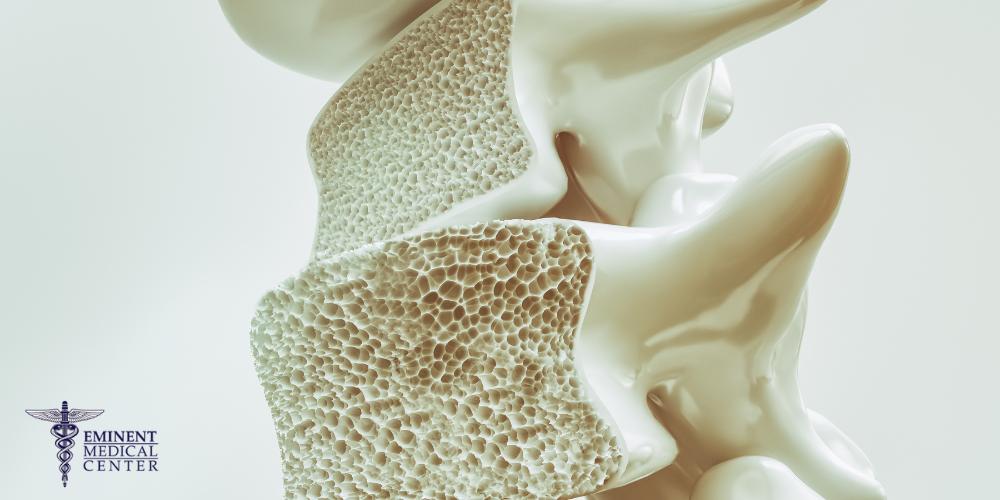Dallas and Richardson Vertebroplasty Surgery Center

Living with spinal compression fractures, osteoporotic spinal fractures, or a fractured vertebra can lead to severe pain, limited mobility, and a lower quality of life. At Eminent Medical Center, we offer a minimally invasive procedure, vertebroplasty in Dallas and Richardson, Texas, that provides pain relief by stabilizing fractured bone using medical-grade bone cement.
Vertebroplasty involves injecting cement into the spinal bone under X-ray guidance to treat compression fractures caused by osteoporosis, skeletal trauma, or injury. This outpatient treatment can help many patients avoid invasive spine surgery, reduce the need for bed rest, and return to normal activities within a few days.
Call Eminent Medical Center today at 469-910-8800 to learn more about vertebroplasty and find out if this minimally invasive spine surgery in Dallas or Richardson, Texas, is right for you.
What is Vertebroplasty?
Vertebroplasty is a minimally invasive procedure used to stabilize vertebral compression fractures and reduce severe pain caused by conditions like osteoporosis, skeletal trauma, or a fractured vertebra. The procedure involves inserting a small needle through the skin and into the spinal bone, where a surgeon will inject bone cement to reinforce the fractured area.
Guided by X-ray images, the cement quickly hardens, restoring stability to the spinal cord and helping many patients feel relief within just a few days. Vertebroplasty is typically performed under local anesthesia or moderate sedation in a specialized medical facility, like Eminent Medical Center.

Difference Between Vertebroplasty and Kyphoplasty
While vertebroplasty and kyphoplasty are both minimally invasive procedures used to treat compression fractures in the spine, there are key differences between the two.
In vertebroplasty, a specialist uses X-ray guidance to inject bone cement directly into the fractured vertebra to stabilize the bone and reduce pain. In kyphoplasty, a small balloon is first inserted into the spinal bone and gently inflated to create space or restore some lost height before the cement is injected.
Vertebroplasty and kyphoplasty are both minimally invasive and designed to relieve pain, improve stability, and help patients regain movement after compression fractures. The choice between the two depends on factors like the severity of the fracture, how long it’s been present, and whether spinal height restoration is a goal.
At Eminent Medical Center, we offer both vertebroplasty and kyphoplasty procedures as a way to treat compression fractures caused by osteoporosis, skeletal trauma, or other conditions that weaken the spinal bone.
What Conditions Does Vertebroplasty Treat?
Doctors recommend vertebroplasty for patients who are experiencing pain and limited mobility due to certain types of vertebral compression fractures. These fractures weaken the spinal bone, often causing the vertebrae to collapse or shift, which can lead to severe pain and further complications if left untreated.
At Eminent Medical Center, our experienced surgeons perform vertebroplasty with precision using X-ray guidance to stabilize the fracture, prevent further collapse, and provide pain relief.
Osteoporotic Spinal Fractures
Osteoporosis is a common cause of spinal compression fractures, especially in older adults. Over time, the bones become brittle and more prone to breaking. These types of fractures often go unnoticed until they cause severe pain or noticeable loss in height and posture.
Vertebroplasty can help treat osteoporotic spinal fractures by injecting bone cement into the weakened vertebra to restore stability and provide pain relief. For many patients in the DFW area, vertebroplasty is an alternative to prolonged bed rest or spine surgery, with relief often felt in just a few days.
Traumatic Vertebral Compression Fractures
Traumatic vertebral compression fractures result from events like car accidents, falls, or other high-impact injuries that damage the spine. These injuries can cause fractured bones, intense pain, and impaired movement.
When conservative treatments like physical therapy, ice packs, or medications don’t work, vertebroplasty can treat compression fractures and reduce the risk of long-term complications.
Spinal Fractures Due to Cancer or Tumors
Some patients develop spinal fractures as a result of cancer that spreads to the spinal bones, weakening the structure and increasing the risk of collapse. These fractures can cause persistent pain, affect the spinal cord, and severely impact mobility.
In these cases, vertebroplasty can strengthen the affected vertebrae, reduce pain, and improve quality of life. Injecting bone cement into the fractured vertebra can help control discomfort and support the spine, especially when combined with other treatments like radiation or chemotherapy.

Additional Treatment Options for Spinal Compression Fractures in Richardson and Dallas, Texas
While vertebroplasty is an effective option for many patients with spinal compression fractures, it’s not the only treatment available. Depending on the cause and extent of the fractured vertebra, some patients may benefit from alternative or additional treatments, such as kyphoplasty, spinal fusion, or spinal decompression.
These options can treat compression fractures, stabilize the spine, and relieve pressure on nerves or the spinal cord to relieve pain and restore mobility.
Kyphoplasty
Kyphoplasty is a minimally invasive procedure similar to vertebroplasty, often used to treat compression fractures. The key difference is that kyphoplasty involves using a small balloon, called a balloon tamp, which is inserted into the fractured bone and gently inflated to restore lost vertebral height. Once the space is created, bone cement is injected to stabilize the area and prevent further collapse. Like vertebroplasty, kyphoplasty is performed under X-ray guidance and can help patients feel relief in just a few days with minimal downtime.
To learn more about kyphoplasty in Richardson or Dallas, Texas, contact Eminent Medical Center.
Spinal Fusion
For patients with spinal instability or multiple compression fractures, spinal fusions are a more extensive surgical option. This procedure involves permanently joining two or more spinal bones (vertebrae) together using bone grafts, screws, or rods. The goal is to prevent movement between the fractured vertebrae, reduce severe pain, and improve structural support.
If the doctor decides that vertebroplasty and kyphoplasty aren’t appropriate, or the patient has progressive deformity or nerve compression, they may perform a spinal fusion instead. Recovery typically takes at least six weeks, and patients must avoid heavy lifting and strenuous activities during this time. For more information about SI joint fusion in Dallas and Richardson, contact Eminent Medical Center today.
Spinal Decompression
Spinal decompression surgery may be necessary when a compression fracture places pressure on the spinal cord or surrounding nerves, leading to symptoms like numbness, weakness, or radiating pain. This procedure involves removing part of the bone or tissue pressing on the nerves to create more space in the spinal canal. Depending on the severity of the damage, decompression may be combined with other treatments like spinal fusion.
While it’s more invasive than vertebroplasty, decompression can be highly effective for patients with nerve-related symptoms who haven’t responded to conservative care or other procedures. To learn more about laminectomy in Dallas and Richardson, TX, contact Eminent Medical Center.
How to Prepare for Vertebroplasty Surgery
Preparing for vertebroplasty surgery begins with a thorough medical evaluation to confirm that the procedure is appropriate for your compression fracture. Your healthcare provider may order imaging studies such as X-rays or an MRI to examine the fractured vertebra and determine the extent of damage to the spinal bone.
Before your vertebroplasty procedure, you may need to stop taking certain medications, such as blood thinners or aspirin, several days before the procedure to reduce the risk of bleeding or other complications. It’s also important to inform your provider if you’ve had any allergic reactions to medications, contrast dye, or anesthesia in the past.
On the day of your procedure, wear loose, comfortable clothing and avoid eating or drinking if instructed. You should also arrange for someone to drive you home, as the procedure is typically performed under moderate sedation, local anesthesia, or sometimes general anesthesia. Following these steps will help ensure a smoother experience and reduce the chance of complications during and after your vertebroplasty surgery.
The Vertebroplasty Procedure
The vertebroplasty procedure is a minimally invasive treatment designed to provide pain relief from spinal compression fractures. Performed in a sterile operating room or procedural suite, the procedure begins with the patient lying face down while the treatment area is numbed with local anesthesia and often combined with moderate sedation.
Using X-ray guidance, your doctor will insert a small needle through the skin into the fractured vertebra. Once in place, the physician carefully injects bone cement into the damaged area. The cement hardens quickly, stabilizing the fractured bone and relieving pressure on surrounding spinal muscles and nerves.
The entire procedure typically takes less than an hour, and most patients are monitored for several hours before going home. Because vertebroplasty involves injecting cement directly into the spinal bone, the risk of cement leakage, infection, or other complications is low, but still carefully managed by experienced specialists at Eminent Medical Center.

Vertebroplasty Recovery Time
Vertebroplasty recovery time is typically short, especially compared to more invasive spine surgery options. Most patients can go home the same day after being monitored for a few hours following the procedure. While some may experience mild soreness at the puncture site, many patients feel relief from their severe pain within a few days and, in some cases, almost immediately.
It’s important to avoid heavy lifting, strenuous activities, and strenuous exertion for at least six weeks to allow the bone cement to fully stabilize the fractured vertebra and reduce stress on the spinal muscles.
Patients are often encouraged to resume light activity shortly after the procedure and may be referred to physical therapy to help rebuild strength and mobility. Applying an ice pack and taking prescribed or regular medications can help manage minor discomfort during the early stages of healing.
Possible Complications of Vertebroplasty Surgery
Although vertebroplasty is considered a safe and minimally invasive procedure, like any medical treatment, there are potential complications to be aware of. Rare but possible risks include infection at the needle insertion site, bleeding, allergic reaction to anesthesia or contrast materials, and cement leakage outside the fractured vertebra. There’s also a small risk of blood clots, especially in patients with reduced mobility before or after the procedure.
In rare cases, leakage could affect nearby nerves or the spinal cord, potentially leading to numbness or weakness. Patients taking blood thinners may face a higher risk of bleeding and should stop taking aspirin or other medications beforehand.
FAQs for Vertebroplasty in the DFW Area
How Painful is Vertebroplasty?
Vertebroplasty is generally well-tolerated and not considered a painful procedure. Most patients receive local anesthesia and moderate sedation, so they remain comfortable during the process, feeling only slight pressure or discomfort at the needle insertion site. Afterward, some mild soreness may occur, but many patients report significant pain relief within a few days.
How Long Does Vertebroplasty Bone Cement Last?
The bone cement used in vertebroplasty is designed to be permanent and typically lasts a lifetime. Once the cement hardens inside the fractured vertebra, it remains stable and durable, providing pain relief and structural support for years without needing replacement.
What Can You Not Do After Vertebroplasty?
After vertebroplasty, patients should avoid heavy lifting, strenuous activities, and strenuous exertion for at least six weeks to allow the bone cement to fully stabilize the fractured vertebra. It’s also important to follow all recovery instructions, including caring for the puncture site and gradually returning to normal movement under the guidance of your care team.
Why Choose Eminent Medical Center for Vertebroplasty in Dallas and Richardson, Texas?
Eminent Medical Center is a trusted choice for vertebroplasty in Dallas and Richardson, TX, because of our commitment to patient-centered, minimally invasive care. Our experienced team uses advanced imaging and precise techniques to safely stabilize compression fractures, helping patients experience meaningful pain relief with a short recovery time. We offer personalized treatment in a modern, comfortable setting, making it easier to get back to living without the constant burden of back pain.
